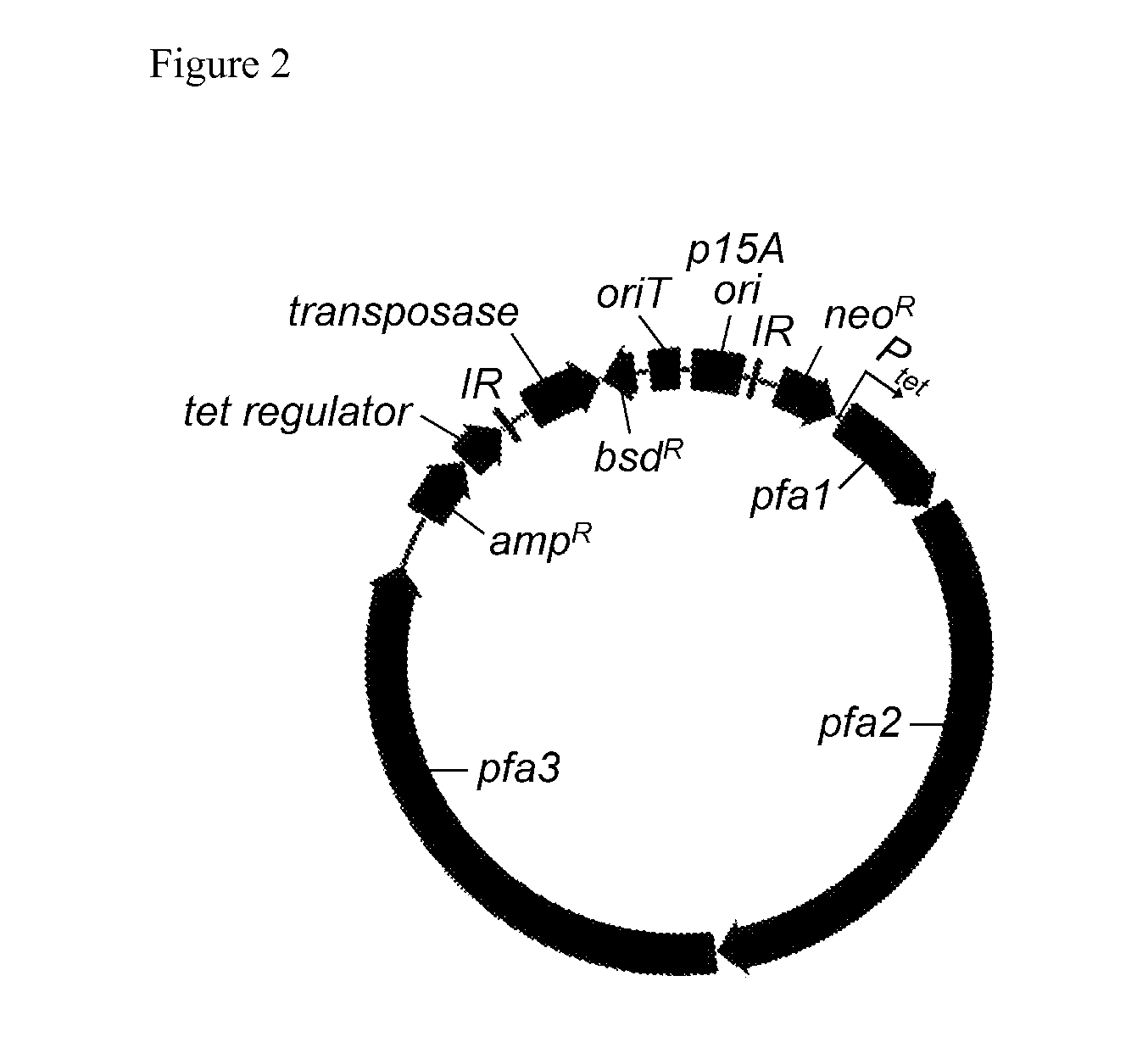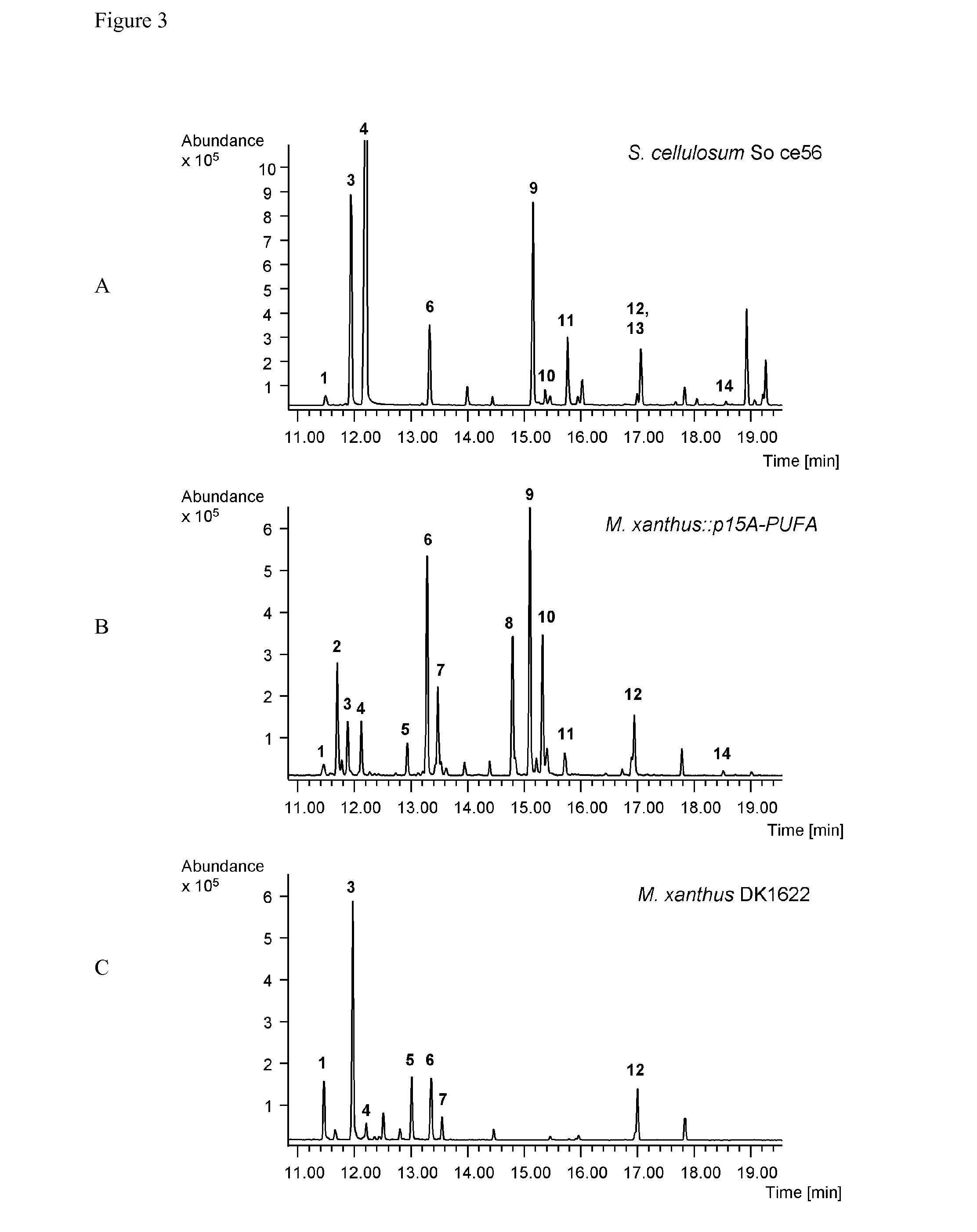Production of fatty acids by heterologous expression of gene clusters from myxobacteria
a technology of myxobacteria and gene clusters, which is applied in the direction of enzymes, biochemistry apparatus and processes, oxidoreductases, etc., can solve the problems of affecting the commercialization of myxobacteria for pufa production on an industrial scale, the difficulty of industrial cultivation of these organisms, and the lack of high grade oil supply with sufficient conten
- Summary
- Abstract
- Description
- Claims
- Application Information
AI Technical Summary
Benefits of technology
Problems solved by technology
Method used
Image
Examples
example 1
Generation of an Expression Construct for a Biosynthetic Gene Cluster for Encoding for the Production of PUFAs
[0153]a) Subcloning of PUFA Genes and Construction of Expression Constructs:
[0154]The PUFA genes were subcloned from the chromosomes of PUFA-producing myxobacterial strains by generating genomic libraries (e.g. using cosmid, fosmid, YAC or BAC vectors) or by amplifying PUFA genes or fragments thereof by PCR followed by subcloning of the PCR products. Alternatively, the PUFA genes were subcloned using methods relying on recombination, e.g. the Red / ET recombination technology (Zhang Y, Nat. Genet. 1998, 20:123-128; Zhang Y, Nat. Biotechnol. 2000, 18:1314-1317) or recombination in yeast (Kouprina N, Nature Protocols 2008, 3:371-377; Larionov V, P. Natl. Acad. Sci. USA 1996, 93:491-496; Wolfgang M C, Proc. Natl. Acad. Sci. U.SA 2003, 100:8484-8489). In another approach the native or artificial DNA sequences of PUFA genes were chemically synthesized de novo (e.g. by gene synthesi...
example 2
Transfer of the Gene Cluster into a Host Organism for Heterologous Production of PUFAs
[0158]The expression constructs of the myxobacterial PUFA biosynthetic gene clusters were transferred into the heterologous host strains by electroporation, conjugation or other transformation methods (e.g. protoplast / spheroblast transformation or using natural competency). The transformants were analyzed genotypically for the presence (and correct integration) of the PUFA gene containing constructs. The host strains containing the myxobacterial PUFA biosynthetic gene clusters were cultivated under appropriate conditions (e.g. for M. xanthus: CTT medium at 30° C. for 2-4 days). PUFA production was analyzed by gas chromatography coupled mass spectrometry (GC-MS) using the FAME method, e.g. analysis of fatty acids methyl esterification.
example 3
Generation of an Expression Construct for the PUFA Biosynthetic Gene Cluster from Aetherobacter fasciculatus DSM 21835 by Conventional Cloning Methods
[0159]The PUFA biosynthetic gene cluster from Aetherobacter fasciculatus DSM 21835 was amplified by PCR from chromosomal DNA. For this, the gene cluster was divided into several regions, which were amplified individually while suitable restriction sites were introduced with the primer sequences. In total, 7 fragments were amplified by PCR: the complete gene pfa1 without its native promoter sequence (1, SwaI-SpeI-pfa1-HpaI), the 5′ end of gene pfa2 (2, HpaI-5′ pfa2-HindIII), the centre section of gene pfa2 (3, HindIII-CRpfa2-NheI), the 3′ end of gene pfa2 (4, NheI-3′ pfa2-AseI), the 5′ end of gene pfa3 (5, AseI-5′ pfa3-HindIII), the centre section of gene pfa3 (6, HindIII-CRpfa3-NheI), and the 3′ end of gene pfa3 (7, NheI-3′ pfa3-SspI-PacI). The PCR products were then subcloned by conventional restriction and ligation methods into a hig...
PUM
| Property | Measurement | Unit |
|---|---|---|
| temperature | aaaaa | aaaaa |
| temperature | aaaaa | aaaaa |
| pulse length | aaaaa | aaaaa |
Abstract
Description
Claims
Application Information
 Login to View More
Login to View More - R&D
- Intellectual Property
- Life Sciences
- Materials
- Tech Scout
- Unparalleled Data Quality
- Higher Quality Content
- 60% Fewer Hallucinations
Browse by: Latest US Patents, China's latest patents, Technical Efficacy Thesaurus, Application Domain, Technology Topic, Popular Technical Reports.
© 2025 PatSnap. All rights reserved.Legal|Privacy policy|Modern Slavery Act Transparency Statement|Sitemap|About US| Contact US: help@patsnap.com



